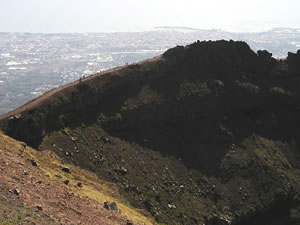Mount Vesuvius, the only active volcano on Europe's mainland, is famous for having erupted and destroyed the ancient Roman city of Pompeii.
A huge, semi-circular crater, known as Monte Somma, cups the cone of Vesuvius, which is formed by the accumulated outpourings of a series of eruptions.
The rim of Monte Somma stands 1,280m (4,200ft) above the Bay of Naples, in Italy. It is thought to be the remnant of a prehistoric volcano that was blasted apart before Vesuvius was born 200,000 years ago.
 Between the rim of Monte Somma and the cone of Vesuvius lies a deep ravine known as the Valle del Gigante, "the giant's valley".
Between the rim of Monte Somma and the cone of Vesuvius lies a deep ravine known as the Valle del Gigante, "the giant's valley".
The Destruction of Pompeii
Mount Vesuvius erupted on August 24, AD 79. Pliny the Younger witnessed the eruption from his home in Misenum on the Bay of Naples, when he was 17 years old. He described it in two letters to the historian Cornelius Tacitus, providing history's first eyewitness account of a volcanic eruption.
Pliny reports seeing "the sea sucked away, and apparently forced back by the earthquake. A dense black cloud was coming up behind us, spreading over the earth like a flood. Darkness fell as if a lamp had been put out in a closed room."
Throughout the towns of Herculaneum, Pompeii and Stabiae, houses and public buildings were ablaze. Next day the dawn failed to materialize, since the black cloud blotted out the sun. A thick layer of ash coated the ground and the few buildings left standing. Working by the light of torches, people gathered valuables together and fled their burning homes, often shaking the dense ash from their hair and clothing.
The outpourings of Vesuvius had engulfed three flourishing towns: Pompeii and Stabiae had been blanketed by 6m (20ft) of ash and dust, while Herculaneum was buried by mud to an average depth of 17m (55ft).
No one knows exactly how many people died, but later excavations revealed the bodies of more than 2,000 people at Pompeii alone.
The Ruins of Pompeii
 During the reconstruction of Resina, a town destroyed in the 1631 eruption, civil engineers digging canals and reservoirs discovered remnants of some Roman buildings in the soil. They aroused little interest.
During the reconstruction of Resina, a town destroyed in the 1631 eruption, civil engineers digging canals and reservoirs discovered remnants of some Roman buildings in the soil. They aroused little interest.
However, in 1738, when some peasants came across several statues and were able to fetch a high price for them, considerable enthusiasm was stirred.
There followed more than a century of looting of the buried towns before Italian archaeologist Giuseppe Fiorelli was commissioned in 1860 to organize a proper exhumation.
The massive layer of ash blanketing Pompeii had preserved much of the detail of town life. As the excavations progressed, Pompeii became more and more like a town stopped dead in time. In addition to luxurious baths and impressive public buildings, Fiorelli's team uncovered 118 taverns, 12 fullers' shops and 10 bakeries.
The most astonishing revelation of all was that the bodies of the volcano's victims had left molds in the solid ash. Fiorelli poured plaster of Paris into the moulds and removed the ash once the plaster had hardened. With this process, he was able to create scenes showing people at the moment of death. These included a sentry trapped at his post, three petty criminals still locked in the stock, and a citizen and his slave loaded down with coins and silver.
Other Eruptions
Between AD 79 and 1036, Vesuvius erupted nine more times before lying dormant for six centuries.
On December 16, 1631, another tremendous eruption destroyed 15 villages nestling on the volcano's slopes and killed more than 3,000 people. Lava flowed down to the waters of the bay and Naples was left knee-deep in ash.
The 1906 eruption of Vesuvius was the worst since 1631. In an observatory, built in 1845 some 610m (2,000ft) up the side of the mountain, vulcanologists watched the fiery explosions with terror.
For 18 days the volcano poured out ash and pumice stone. Villages on the slopes to the north and east were buried, as were 775sq.km (300sq.mi) of cultivated land. The width of the crater increased by about 300m (1,000ft) while the height of its rim fell by 220m (720ft) to 1,277m (4,190ft).
Since the relatively minor eruption of 1944, Vesuvius has lain dormant.